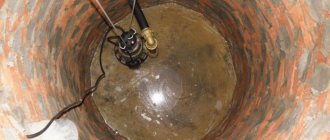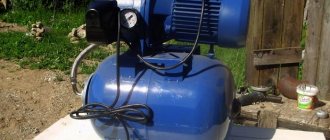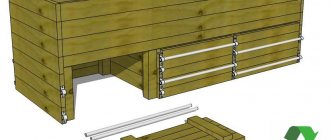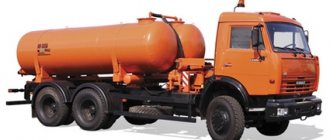Any person knows what a pump is and has used it at least once. But vacuum design is a completely different matter. Many people believe that such a device is used exclusively for production purposes, and is not suitable for personal use. But they are wrong. The device is great for home use, but its price is high. Therefore, many people are thinking about making a vacuum pump with their own hands.
Design #6 - American or spiral type
The spiral pump uses the energy of the river flow. To operate, the minimum requirements must be met: depth - at least 30cm, flow speed - at least 1.5 m/s.
Option 1
Necessary materials:
- flexible hose d.50mm;
- several clamps according to the diameter of the hose;
- intake - PVC pipe 150mm;
- wheel;
- pipe reducer.
The main difficulty in such a pump is the pipe reducer. This can be found in decommissioned sewer trucks or obtained from factory equipment.
For greater efficiency, an impeller is attached to the pump
The flexible hose is attached to the wheel in a spiral using clamps. An intake made of PVC pipe 150mm is connected to one end. The second end of the hose is put on the pipe reducer.
Water is taken in by the water intake and moves in a spiral, creating the necessary pressure in the system. The lifting height depends on the flow speed and the immersion depth of the intake.
Option 2
Necessary materials:
- flexible hose d.12mm (5);
- plastic barrel d.50cm, length 90cm (7);
- polystyrene foam (4);
- impeller (3);
- sleeve coupling (2);
We cut an intake hole in the bottom of the barrel. Inside the barrel, it is necessary to lay the hose tightly in a spiral and connect it to the sleeve coupling.
Inside the barrel, the hose is laid tightly, pressed against the walls with a strip. The barrel can be metal with foam floats
To impart buoyancy, foam floats must be glued inside the barrel. Finally, screw on the impeller.
For this design option, the drain hose must be 25 mm. in diameter.
Instructions for use
The result of using a vacuum pump is possible if a number of rules are observed. It is important to monitor your sensations. If you immediately feel discomfort, then the design was assembled incorrectly and will harm men’s health.
Rules of application:
- for the first time no more than 5 minutes;
- Before each use of the structure, the flask and the genital organ are thoroughly washed;
- home appliances and penis are treated with cream;
- do not use in the cold, with a frozen penis;
- after inserting the penis into the cylinder, gradually pump out the air until the penis becomes completely erect in a state of vacuum;
- use a clothespin for the tube to prevent air from getting back in;
- 30-40 minutes is enough for the member to complete the procedure.
Expert opinion
Nikolay Efremov
Bachelor. An experienced stallion. Proud of his 20 centimeters.
Recommend for beginners
By following simple recommendations, you can quickly increase your penis size to 20 cm and increase your stamina.
Design #8 - device from a washing machine
Often, parts or even entire units from old things remain on the farm. You can remove a centrifugal pump from a washing machine that is no longer needed. This pump is perfect for pumping water from a depth of up to 2 meters.
Necessary materials:
- centrifugal pump from a washing machine;
- petal valve from a washing machine or homemade one;
- plug, bottle stopper;
- hose;
- preferably an isolation transformer.
If you use a ready-made valve from a washing machine, it needs to be modified. One hole needs to be plugged, for example using a bottle cap.
Excess pump holes must be plugged. If the case is metal, grounding is required
We connect the petal valve to the hose and lower it into a pit or well. Connect the second end of the hose to the pump.
For the system to start working, it is necessary to fill the hose with the valve and the pump itself with water. All that remains is to connect the transformer, and the pump is ready for use.
Buy ready-made or make it yourself
The question of whether to tinker with it yourself or buy a ready-made pump worries many. Online stores sell sexual toys and erotic gadgets in abundance. Any cost, sizes, colors, shapes. It is possible to confidentially order a vacuum pump with home delivery and not worry about the quality of the product.
Which magnification device is better?
PumpExtender
But
a homemade simulator also has its advantages. It can be used as a first toy, get new sensations, and understand whether it is necessary at all .
A homemade exercise machine can be several times cheaper than a purchased one. The service life with high-quality assembly is long.
Vacuum device from compressor
A more powerful device can be obtained from a compressor, which is present in air conditioners or refrigerators. Step-by-step master class on self-assembly of the unit:
- Release the compressor from the evaporator and condenser. To do this, you need to cut the copper tubes that connect the devices.
- Correctly connect the compressor to the electrical network.
- Attach a fine air filter to the inlet of the device (can be purchased at any auto store).
- Attach a flexible hose of the required diameter to the outlet of the device.
- Connect the compressor to the network.
Using such a unit, you cannot pump out air masses that contain a lot of water vapor. This may cause the device to malfunction. In this case, it is necessary to make a receiver and a sump. Such parts will work together as a drainage device.
You can make your own vacuum pump from an aquarium compressor. To do this, you need to disassemble it and remove the check valves. When the valves are turned over, the compressor will begin to pump out air instead of pumping. The procedure is similar to making a device from a car pump.
Design #1 - liquid overflow pump
This pump will most likely be the simplest and cheapest. To implement it, the following materials are required:
- plastic bottle with stopper;
- plastic bottle without cork;
- a piece of plastic pipe of suitable diameter;
- spout hose
First, you need to make a reed valve.
Remove the gasket from the cap of the plastic bottle. We cut it in a circle so that the diameter of the gasket becomes smaller than the neck of the bottle. At the same time, you need to leave a narrow sector untouched, about 15-20 degrees.
The sector must be left such a width that it can swing easily, but not come off
Drill a hole in the center of the plastic bottle cap, approximately 8 mm. Insert the gasket and screw on the cut neck.
The purpose of screwing the neck is to clamp the membrane and create a reed valve
We insert a plastic pipe into the finished valve. Cut off the top of the second plastic bottle. You should end up with something similar to a funnel. We fix it on top of the plastic pipe.
We put a spout hose on the other end of the plastic pipe. The simplest homemade water pump is ready.
The cone-shaped part will help the liquid to open the petal. In addition, the valve will not hit the bottom
By moving your hand sharply up and down, we force the liquid to rise through the plastic pipe to the spout. Then the liquid will flow by gravity.
There are also other options:
Image gallery
Photo from
The most popular and easiest to implement type of pump is a piston pump with a handle
To manufacture a piston pump system, you will need a housing from a submersible pump or steel pipes of different diameters
To manufacture a centrifugal pump, you will need a drive that performs rotational movements.
To build a vibration unit, you need not only available tools, but also knowledge in electrical engineering. The pump performs electromagnetic oscillations to transport water
The most common homemade option
Homemade piston pump model
An ingenious centrifugal solution
Homemade vibration unit
Working principle of a vacuum pump
Before assembling the structure, it is necessary to disassemble what parts it consists of and how it works. The principle of operation is not very different from the operation of conventional pumping equipment; when the valves are turned to the opposite side, a vacuum device is obtained. Pump performance is achieved by sealing the system, otherwise the power drops.
You should also monitor the condition of the intake tract, because... During pumping, debris may get in, which clogs the installation channels.
There are basic principles of operation of a vacuum pump:
- A moving element consisting of a piston, membrane, or rotor creates a vacuum in the cylinder through suction mode. At this moment, the exhaust valve is closed, the intake valve is open as much as possible.
- During the reverse stroke, the intake valve moves to a closed state, leaving a low level of pressure in the intake chamber. The gas is released through the exhaust hole, and the cylinder is filled to its minimum level.
Vacuum pump device
Vacuum pump motor design
This cycle of operation is applied to piston installations; the blade has a rotary arrangement, which moves the suction chamber in a circle, at certain points connecting it to the inlet and outlet openings. The operating principle will help you figure out how to properly make a vacuum pump with your own hands.
Low vacuum unit
It is quite difficult to make it yourself in the absence of a lathe, welding machine and without special skills. A cylindrical body is required for manufacturing. It should contain a shaft equipped with a blade wheel. When water is supplied, the wheel rotates and, under the influence of centrifugal forces, a vacuum will certainly be created in the device.
The mechanism operates using an electric motor. The impeller should not be installed directly in the center. This is necessary so that the gaseous mass is injected and pushed through the system. The disadvantage of such a device is that the liquid that makes the device work constantly heats up and needs to be replaced.
The device must be equipped with inlet openings. With their help, the liquid will flow inside. In addition, there must be outlets through which gas can escape. Similar mechanisms are used in large enterprises, as well as in agricultural work, to remove gas mixed with sand or dust. For continuous operation, it is necessary to provide a gas outlet, a constant supply of liquid and a motor cooling system.
The mechanism operates using an electric motor. The impeller should not be installed directly in the center.
Varieties of homemade structures
There can be many types of pumps. It depends on their intended purpose. The simplest vacuum sealer can rightfully be considered a medical syringe. But its disadvantage is that a vacuum can be created in small volumes. And even if you don’t have a medical syringe at home, you can easily buy one at the pharmacy, just pay attention to the size.
But in order to be able to pack large volumes, a car pump is well suited. It just needs to be reworked to the required parameters. Moreover, making a vacuum pump from a car compressor with your own hands is not difficult.
You can also construct a vacuum pump from a compressor from a refrigerator, or remake accessories from an aquarium.
Using a car pump
A homemade vacuum pump can be made from different raw materials. The most popular options are car and bicycle hand pumps.
Common manufacturing mistakes
For a number of reasons, a homemade device may not work. The main flaws are due to non-compliance with assembly rules. The vacuum mechanism is assembled easily and quickly , but the slightest mistake can cause pain.
The most common mistakes:
- plastic covers - the material must be soft (rubber);
- weak seal - if the tube is too small for the hole, it will cause painful sensations in the testicles;
- long tube – vacuum effect is reduced;
- cylinder too large;
- mismatch between the container and the pump;
- short adapter – causes pain;
- a thin tube will pop out during the process.
Design #13 - Shukhov wick pump
The Russian inventor Shukhov became famous for many buildings, including the radio tower in Moscow. Below we will discuss another of his inventions - a water pump.
Pulleys are made composite. The depth of the groove should be slightly less than the swollen rope
The pump uses a special rope to operate. This rope consists of woven cotton threads with a total thickness of 5-6 mm, enclosed in a sheath. The thread is passed through the pulleys.
When movement occurs, the rope gets wet and wraps around the pulleys. The pulley (5) with the help of a spring (4) presses the rope against the pulley (3) with force. The squeezed water flows into the tray (7).
Figure “c” shows sections of pulleys (3) and (5), respectively.
To operate the entire system, an electric motor of only 5-10 watts is required. Typically, such engines have 1500 rpm.
To reduce speed and increase force, you can use a worm gear, shown in figure “c”. It is quite possible to make it by hand. To do this, you need to find a suitable gear and make a worm from wire. Small forces on the shaft allow manufacturing inaccuracies.
Troubleshooting
A vacuum pump for pumping air, like any other mechanism, can break or malfunction. We have listed the most common breakdowns above, and now you need to figure out how to fix them:
- Motor faulty or incorrectly connected. The most common mistake is a broken connection diagram. Initially, you need to check the power, that is, the integrity of the network cable. To do this you will need an indicator probe. If the probe lights up and the motor rotates after power is applied, this means that this is not the cause of the breakdown. If not, then this means the engine is faulty and will have to be sent in for repair.
- Inconsistency between the drive and the injection mechanism shaft. This problem is most often solved by installing a gasket under the engine or under the injection mechanism. If after this the pump does not resume operation, then you need to inspect the coupling for displacement or deformation. In this case, the part is installed in place or changed.
- Jamming of the working element in the discharge mechanism. Typically this problem occurs due to contamination of the pumped medium. To eliminate the malfunction, you need to disassemble the product and clean it.
- Breakage of bearings in support units. This problem is accompanied by loud noise and strong vibration. This means that the bearing has failed and needs to be replaced.
- The appearance of scale on working elements. This problem usually appears on liquid ring pumps in which the working medium is water. To resuscitate the unit, you need to get rid of salt deposits using a special composition.
- Overheating of the pump and subsequent wear of parts. This problem is especially relevant for oil-free rotary vane units. Even the most modern materials, such as Teflon, are unable to fully compensate for the missing lubricant. This is why it is so important to observe the temperature regime. If overheating does occur, the damaged parts will have to be replaced.
- Excess or leakage of working fluid. If the liquid ring pump has reduced its performance, you need to check the pressure of the service fluid. It could have fallen due to its leakage. The solution to the problem is to replace the seal in the hole.
If the seal is in satisfactory condition, then the problem is in the flange connections - you need to replace the gaskets there.
Also, the intensity of fluid consumption may be due to severe wear of parts. This usually happens when the pump has already served its purpose and needs to be replaced or the unit needs to be checked; perhaps it is still repairable, and only the most worn parts need to be replaced.
If the pressure of the service medium is high, due to its excess or overheating, the device may also break down. If you set the optimal values, the pump will work perfectly again. If the temperature is maintained, then you need to reduce the water supply or close the valve on the pressure pipeline.
Design #11 - pump from a bicycle wheel
Productive pump based on two wheels. Necessary materials:
- PVC sewer pipes and outlets;
- bicycle wheel;
- nylon rope;
- small pulley;
- several pistons;
- mounting rod.
The operating principle of this pump is similar to that of a dragline.
First you need to build a sleeve from a sewer pipe that will be immersed in water. A drain is placed on the top of the sleeve through which water will flow.
Next, install a small pulley on the bottom (a wheel rim from a wheelbarrow will do) and a bicycle wheel on top.
We attach a series of pistons along the entire length of the rope, first passing them through the sleeve. The rope should go around the pulley and the bicycle wheel.
The device is very effective, especially if you use a bicycle drive. It will be much easier to twist your legs.
By rotating the bicycle wheel, each piston on the rope captures water and, like an elevator, lifts it upward. The water column pours into the outlet.
Design #2 - manual pump with direct spout
A very simple device for pumping water from a barrel or well. The advantages of this design: speed of assembly, low cost.
Required parts:
- PVC pipe d.50mm – 1 pc.;
- PVC coupling d.50mm – 1 piece;
- PPR pipe d.24mm – 1 pc.;
- PPR branch no. 24 – 1 piece;
- PVC plug d.50mm – 2 pcs.;
- piece of rubber, diameter 50mm, thickness 3-4mm – 1 piece;
- check valve 15mm – 1 piece;
- empty silicone bottle 330ml – 1 piece;
- tightening screw clamp – 1 piece;
- screw-nut or rivet – 1 piece;
- union nut no. 15 – 1 pc.
We begin the assembly of the entire structure with the manufacture of a check valve.
Construction of a check valve. We prepare a check valve from a Ø 50mm plug. We drill several holes around the perimeter of the plug Ø 5-6mm. In the center we drill a hole of suitable diameter for a screw-nut pair or rivet.
On the inside of the plug we place a rubber disk Ø 50mm. The disc should not rub against the walls of the plug, but should cover all drilled holes. We tighten it in the center with a screw-nut or rivet; a screw will not work.
If difficulties arise with materials or manufacturing, you can replace it with a factory-ready check valve.
Preparing the pump sleeve. The length of the sleeve should be commensurate with the depth of the well or container with water. We cut the PVC sewer pipe Ø 50mm to the required length, from the narrow end. We insert the newly made valve into the pipe socket. For reliability, we fasten it on both sides with self-tapping screws.
For the second end we prepare a plug with a pre-drilled hole Ø 25mm. This hole in the plug is made according to the diameter of the PPR pipe Ø 24. Great precision is not required, the plug serves as a sliding support.
Piston assembly procedure. Cut off the spout of an empty silicone container. Next, you need to heat the balloon and insert the sleeve into the PVC so that the diameter of the balloon exactly matches the diameter of the sleeve. Place the silicone can on the valve from the reverse side of the arrow (the arrow on the check valve shows the direction of water movement).
We cut off the excess balloon. We secure it with a union nut no. 15.
Pump rod design. The length of the rod should be 50-60 cm greater than the length of the sleeve. You need to heat one end of the rod and insert a check valve. The arrow on the check valve should point towards the inside of the stem. Until the pipe has completely cooled down, we tighten it with a screw clamp.
Final assembly of the pump. We insert the rod into the sleeve and attach a plug (sliding support) through the coupling on top. To top it off, we attach a 24mm PPR bend to the end of the rod pipe. All you have to do is connect the hose and you can pump water.
The pipe material can be any, and the cross-section is not necessarily round. It is important to select the appropriate piston for the liner
The outlet serves as a support for the hand. For convenience, you can take a tee and plug one side of it.
What's the result?
Sooner or later, all men think about the size of their penis. I want to be the best lover, have masculine self-confidence, give unforgettable pleasure to myself and pleasure to my partner. A DIY vacuum pump becomes a real salvation. With just a few uses, it increases the length of the penis by several centimeters , fights premature ejaculation and weak potency.
A homemade exercise machine is a cheap pleasure. Production time is no more than 40 minutes. The main advantage is ease of use and quick effect. Blood circulation will be normalized, endurance in bed will increase, libido will improve.
GOODNESS! 1
Using a medical syringe
Such a device will certainly come in handy on the farm if you need to pump out liquid or gas in small volumes. The following parts are required for operation:
- plastic tee;
- flexible plastic pipe, its diameter should be identical to the holes of the tee and syringe;
- 2 check valves for aquarium;
- a syringe, the volume of which depends on the power of the device (the larger the syringe, the greater the power).
The plastic pipe is cut into pieces 10 cm in size, and then attached to the tee. The tubes should fit snugly to the spout of the tee. This is necessary so that they do not jump off under pressure during operation of the device.
The syringe tip is then attached to the central tube. The entire structure is presented in the form of a tee, on the sides of which two pieces of hose are fixed, as well as a syringe located at right angles to the retracted ends.
The next step is to install the valves. They are often marked with an indicating arrow. One of them should be placed so that the arrow points away from the tee, and the second - with the arrow pointing towards it. In general, the system will be similar to an entry-exit sign.
The handheld device is ready. It can be used to pump water from one container to another by placing one valve in the liquid and the other in the pumping container. The arrows act as guides. You need to immerse the valve in the water, the pointer of which points to the tee. The system will work when the piston on the syringe begins to move.
Design #7 - wave energy pump
As the name suggests, such pumps use wave energy. Of course, the waves on the lakes are not that big, but the pump works around the clock and is capable of pumping up to 20 cubic meters per day.
Option 1
Necessary materials:
- float;
- corrugated pipe;
- two valves;
- mounting mast.
The float is a pipe, a log, selected depending on the rigidity of the corrugated pipe, experimentally.
Corrugated pipe can be made of plastic or metal. The weight of the log must be selected experimentally
Two valves operating in the same direction are mounted in a corrugated pipe.
As the float moves downwards, the corrugated pipe stretches, resulting in water intake. When the float moves up, the corrugation contracts and pushes the water up. Therefore, the float must be quite heavy and large.
The entire structure is rigidly attached to the mast.
Option 2
This design differs from the first option in that the corrugated pipe is replaced by a brake chamber. This diaphragm-based scheme is very often used in simple DIY water pumps. Such a pump is quite versatile and can receive energy from wind, water, steam, and sun.
The brake chamber should be disassembled and only two holes left for the valves.
Instead of homemade valves, you can use ready-made plumbing valves. The washers must be of sufficient diameter so that the diaphragm does not tear (+)
Manufacturing suitable valves is a separate task.
Necessary materials:
- copper or brass tube;
- balls of slightly larger diameter - 2 pcs.;
- spring;
- copper strip or rod;
- rubber.
For the inlet valve, cut off the tube and drill it out so that the ball sits tightly on the tube. It is necessary to ensure that the ball does not allow water to pass through. To prevent the ball from falling out, solder a wire or strip on top.
The design of the exhaust valve differs from the intake valve in the presence of a spring. The spring must be installed between the ball and the copper strip.
We cut out a diaphragm from rubber to the size of the brake chamber. To drive the diaphragm, you need to drill a hole in the center and stretch the pin. We insert the valves from the bottom of the brake chamber. For sealing, you can use epoxy glue.
It is better to find non-metal balls for valves, so they will not be subject to corrosion.
Option 3
Based on the design of the two previous options, you can think about building a more advanced model.
It is advisable to choose a log that is dry and not resinous, so it will be lighter, pay attention to the absence of cracks
For this pump it is necessary to drive four stakes (1) into the bottom of the reservoir. Then make a float from a log. You need to make cuts in the log so that it does not rotate when swinging on the waves.
For durability, it is recommended to treat the log with a hot mixture of kerosene and drying oil. It must be done carefully, processed in a water bath: there should be no open flame.
The log travel limiters (3) and (4) are nailed in such a way that the log does not damage the pump rod (5) during maximum movement.











